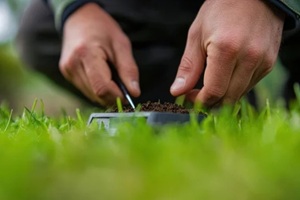
When autumn arrives, most homeowners turn their attention to raking leaves and preparing their lawns for winter. However, another seasonal task that often gets overlooked is testing your soil. Fall represents an ideal soil testing window, providing valuable time to address nutrient deficiencies before spring growth begins. Grasping the underlying factors can determine whether trees simply endure or truly flourish.
This article examines why fall soil testing matters for tree health, what these tests reveal, and how working with professional arborists can set your green space up for success.
Reasons Why Autumn is the Ideal Season for Soil Testing
Conducting soil tests in the fall provides distinctive benefits compared to other times of the year. The cooler temperatures slow microbial activity, which provides a more accurate snapshot of your soil’s baseline nutrient levels. Fall soil tests offer property owners several months to implement recommendations before the growing season begins.
Trees absorb nutrients most actively during their growing season, but their roots continue developing well into fall. Testing now means any amendments added to the soil have time to integrate and become available to root systems. For example, lime applications can take several months to effectively adjust soil pH levels. By spring, when trees break dormancy, the nutrients they need are already in place.
What Soil Tests Reveal About Your Trees’ Environment
A complete soil test measures macronutrients, including nitrogen, phosphorus, and potassium, as well as secondary nutrients such as calcium and magnesium. The findings also highlight the availability of micronutrients such as iron, manganese, and zinc, which trees need in smaller amounts but are still essential for their growth.
Soil pH influences how well trees can access available nutrients. Most nutrients become less available to plants when soil pH falls outside the optimal range of 6.0 to 7.0. Even if nutrients are present in the soil, extreme pH levels can prevent them from being taken up by the roots. Virginia’s naturally acidic soils mean many properties benefit from periodic lime applications.
Professional soil testing also identifies problems, such as excess salts, which can accumulate from de-icing products or improper fertilization.
The Link Between Tree Vitality and Soil Health

Trees communicate their needs through visible symptoms, but by the time nutrient deficiencies become obvious, damage may already be occurring. Yellowing leaves, reduced growth, and a heightened vulnerability to pests and diseases frequently occur due to imbalances in the soil.
Healthy soil contains billions of beneficial microorganisms that help trees absorb nutrients and resist diseases. When soil pH or nutrient levels fall out of balance, these beneficial organisms struggle to develop, creating a cascade effect that weakens the entire tree system.
Mature trees possess wide-ranging root systems that can reach up to two to three times the area of their canopy spread. Professional soil testing accounts for this complexity by collecting samples from multiple locations around valuable trees.
How Professional Arborists Interpret and Apply Results
While home soil test kits exist, they provide limited information compared to laboratory analyses. Laboratories obtain samples from certified arborists and deliver thorough reports that include customized recommendations. Certified arborists understand how to interpret these results within the context of tree species, site conditions, and property goals.
Different species of trees have varying nutrient needs and preferences for soil pH. Oaks, for instance, generally tolerate slightly acidic soils, while other species may require different conditions. Arborists consider these preferences when developing treatment plans.
The timing and method of applying soil amendments matter significantly. Professional tree care companies utilize specialized equipment for deep-root fertilization, delivering nutrients directly where trees can access them. They also understand proper application rates because excessive amendments can be as harmful as deficiencies.
Long-Term Benefits of Regular Soil Testing
Annual or biennial soil testing creates a valuable record of changing conditions over time. This historical data helps arborists perform an analysis of how previous treatments were effective and adjust future strategies accordingly.
Property owners who invest in consistent soil testing often see multiple benefits:
- Reduced fertilizer costs through targeted applications rather than blanket treatments
- Improved tree resilience during drought or stress periods
- Enhanced property aesthetics from vigorous, healthy trees
- Extended lifespan for valuable specimen trees
- Better return on investment for other tree care services
Trees growing in optimal soil conditions respond better to pruning, resist storm damage more effectively, and recover faster from pest or disease pressures. The soil test itself is just the starting point; the real value comes from implementing informed strategies based on scientific data.
Partner With RTEC Treecare for Professional Soil Analysis

Fall soil testing is not just about collecting data; it’s about creating healthier trees that add lasting value to your Virginia property. RTEC Treecare’s ISA-certified arborists understand the specific soil challenges impacting trees in our region and how to address them through environmentally responsible practices. We use accredited laboratory analysis and interpret results within the context of your outdoor space needs.
Rather than offering generic recommendations, RTEC Treecare develops customized treatment plans that take into account your property’s conditions, tree species, and preferences. Our preservation-based approach means every recommendation serves the goal of building sustainable, flourishing landscapes.
Contact RTEC Treecare online or call (571) 240-4683 to schedule a fall soil test and consultation. Our responsive team will develop a soil management strategy that sets your trees up for exceptional health when spring arrives.


